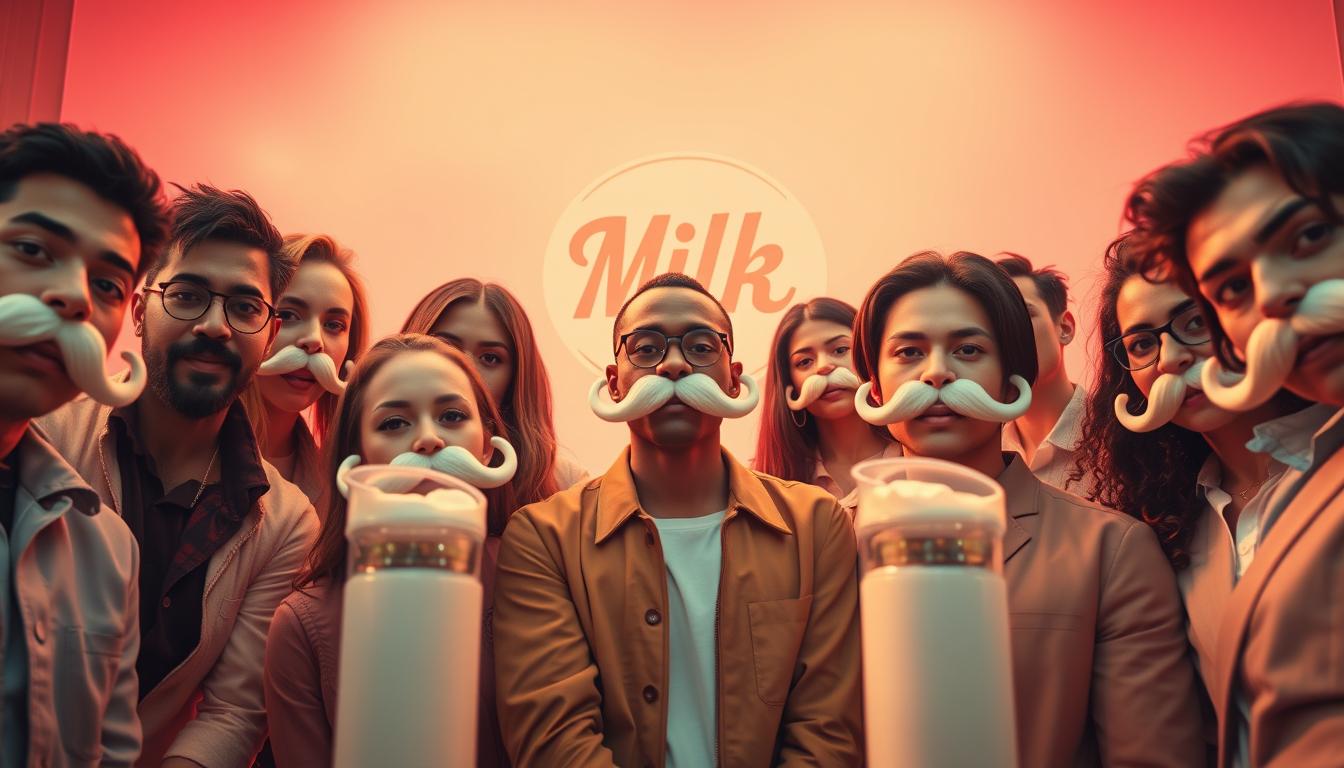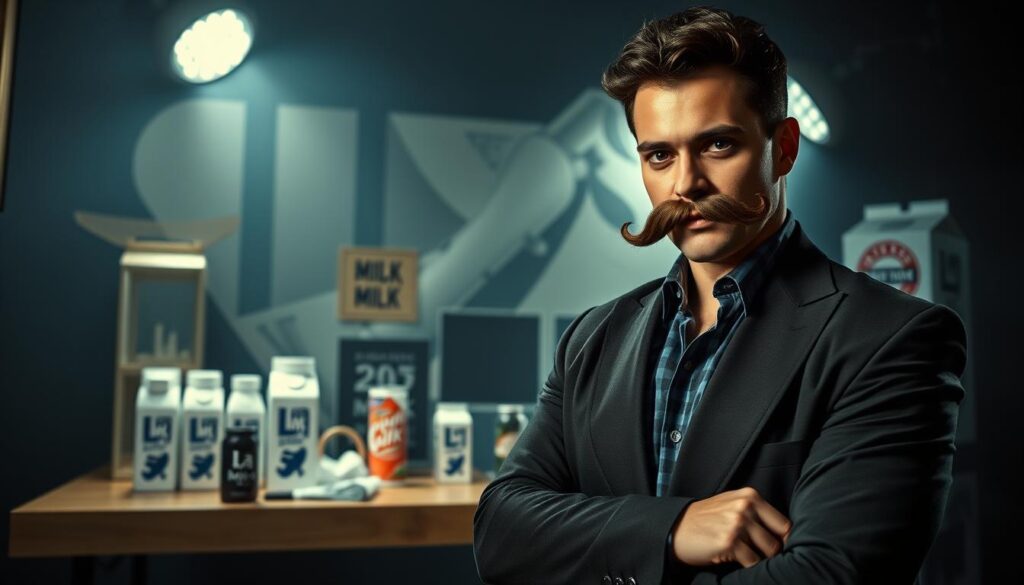
Did you know that by the early 1990s, Americans were consuming less than half a cup of milk per person per day? This stark decline from the post-World War II surplus led to a crisis in the dairy industry. To combat this, the “Got Milk?” campaign was launched in 1993, becoming one of the most iconic advertising efforts in history.
The campaign, created by the ad agency Goodby, Silverstein & Partners, featured celebrities like Naomi Campbell, who became the first celebrity endorser in 1994. Its unique approach highlighted the absence of milk in everyday life, creating a sense of urgency and rebranding milk as both healthy and trendy. Although it didn’t significantly boost sales, the campaign’s influence was undeniable, resonating with over 80% of the population by 1997.
This innovative strategy was part of a broader movement to revitalize milk’s image, as detailed in the transparent tech revolution. The campaign’s legacy lies in its ability to shift cultural perceptions, making milk cool again through clever storytelling and celebrity endorsements.
The Changing Landscape of Dairy Advertising
By the early 1990s, milk consumption in America had dropped to less than half a cup per person daily. This decline was part of a larger trend that began in the mid-20th century, with per capita milk intake falling by 23% between 1955 and 1990. Changing consumer habits and growing health concerns played significant roles in this downward trend.
Declining Milk Consumption and Industry Challenges
The dairy industry faced stiff competition from soft drinks and shifting dining habits. As people opted for convenience and perceived healthier alternatives, traditional milk sales suffered. This shift prompted the industry to rethink its approach, leading to a strategic focus on advertising.
Government Initiatives and Checkoff Programs
In response to these challenges, government-backed initiatives and agricultural commodity checkoff programs emerged. These programs reallocated surpluses toward marketing efforts, funding campaigns that would become iconic. The Milk Processor Education Program, for instance, financed the “Got Milk?” campaign, which used memorable taglines and visual icons to reposition milk in the market.
| Year | Milk Consumption | Key Events |
|---|---|---|
| 1945 | Peak consumption | Milk consumption begins to decline post-WWII |
| 1990 | 0.78 cups/day | Launch of “Got Milk?” campaign |
| 2010-2017 | Fell by 2.5% annually | Rise of plant-based milk alternatives |
These initiatives not only countered falling consumption but also reshaped how milk was perceived culturally. The use of witty, innovative campaigns became a cornerstone of the industry’s strategy to appeal to a broader audience.
For more insights into how advertising strategies have evolved, visit this link to explore the impact of digital shifts on marketing.
Inside the Milk Mustache Campaign: Strategy and Impact
The “Mustache Campaign” became a landmark in advertising history, blending creativity with strategic insights to revive milk’s appeal. Launched in the mid-1990s, it introduced a fresh approach to marketing dairy products.
Innovative Advertising Tactics and Creative Concepts
The campaign’s success hinged on its innovative tactics. Ad executive Jeff Manning and Goodby, Silverstein & Partners crafted a strategy that stood out. They used celebrity endorsements, like David Beckham and Britney Spears, to grab attention. The iconic mustache imagery, often accompanied by witty taglines, became instantly recognizable.
- Celebrity endorsements added glamour and relatability.
- Humorous and emotional storytelling connected with diverse audiences.
- Visual appeal made the campaign memorable and shareable.

Measurable Sales Impact and Consumer Perception Shifts
The campaign showed tangible results. Milk sales saw a modest 6% increase in the mid-1990s, indicating its effectiveness. Consumer perception shifted, with milk being seen as a trendy, essential beverage. The campaign’s adaptability was key; it initially targeted traditional beverage consumers before addressing plant-based trends.
For more insights into how advertising strategies impact consumer behavior, visit this link to explore innovative marketing solutions.
Celebrity Influence and Cultural Shifts in Milk Marketing
The “Got Milk?” campaign became a cultural phenomenon, largely due to its clever use of celebrity endorsements. By featuring A-listers like Tyra Banks and Annie Leibovitz, the campaign transformed milk into a trendy, must-have product. This strategy not only captured attention but also redefined how dairy products were marketed.
Star-Studded Mustaches and Pop Culture Phenomena
Celebrities sporting milk mustaches created iconic imagery that resonated across generations. These visuals, often shot by renowned photographers, became instantly recognizable. The campaign’s success lay in its ability to merge pop culture with everyday life, making milk a symbol of both nostalgia and modernity.

Legacy of “Got Milk?” and Modern Adaptations
The campaign’s impact extended beyond its time. While it didn’t significantly boost long-term sales, it influenced marketing strategies. Modern brands, like Silk, have adapted the concept for plant-based alternatives, showing its enduring relevance. The blend of celebrity influence and creative storytelling continues to shape contemporary marketing, proving the power of cultural adaptation.
| Year | Marketing Strategy | Impact |
|---|---|---|
| 1990s | Celebrity Endorsements | Repositioned milk as trendy |
| 2000s | Pop Culture Integration | Increased brand recognition |
| 2010s | Adaptation by Plant-Based Brands | Expanded market reach |
“The ‘Got Milk?’ campaign’s true legacy is its ability to evolve, influencing how brands connect with diverse audiences.”
Conclusion
The “Milk Mustache” campaign stands as a testament to the power of innovative advertising and celebrity influence. By leveraging endorsements from well-known figures, the initiative transformed the way people viewed milk, making it a symbol of both health and pop culture.
Over time, the campaign’s impact extended beyond its initial success. Funded by the Milk Processor Education Program, it set a new standard for dairy advertising. The program’s efforts not only boosted milk’s image but also laid the groundwork for modern marketing strategies.
Despite its achievements, shifting consumer habits led to a decline in milk consumption. By the 2010s, per capita intake had dropped by about 2.5% annually. This trend reflected a broader movement toward plant-based alternatives, highlighting the evolving nature of consumer preferences.
Today, the legacy of the “Milk Mustache” campaign is evident in its influence on both traditional dairy and plant-based products. Its innovative approach and cultural resonance continue to inspire marketers, proving its enduring impact on advertising history.

 The “Milk Mustache” Campaign: Making Milk Cool with Celebrities
The “Milk Mustache” Campaign: Making Milk Cool with Celebrities
0 Comment